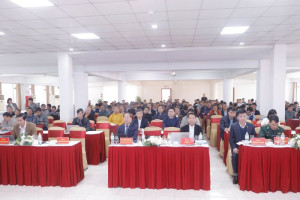
In previous days, the harm caused to the archeological area C and D of Thang Long citadel world relic created pressing sentiments in society. It became a hot issue when the Vietnam Archeological Council sent an urgent complaint to the Prime Minister and concerned agencies for immediate protection of this important relic.
Restoration was like… destruction!
For many years, there have been an increasing number of cases that the restoration of relic caused harms to the original structure of relics, including relics of large scales and historical & culture importance. These cases include the restoration of Mac citadel relic in Tuyen Quang province, the upgrade of Quan Chuong Gate, the new construction of Tran Quoc pagoda’s Triple Gate, the ancestral worshipping hall and musical stone penthouse of Tram Gian pagoda in Ha Noi, the repair of Ngô Quyền temple in Son Tay…. Other recent restoration cases involved Long Bien bridge - a historical heritage, So pagoda in Ha Noi (or Hoi Lim quan) in Ha Noi build in 1527 - a heritage symbolizing many architectural distinctives from Mac Dynasty to Nguyen dynasty, and the famouse Tien Canh communal house in Vinh Phuc where its restoration was like… destruction. It’s all alarming that disregard of heritages and violations against the law on cultural heritages have happened not only in parts of communities but also in administrative authorities and agencies in charge of cultural management.
The architecture of a relic is a symbol of a dynasty, a historical witness as well as a valuable treasure of the national culture. Each relic existing still today can tell a lot about the social, economic and cultural development of the nation in a historical period.
In Hanoi, until 1980s, the restoration work had been mostly financed by State’s limited fund. Therefore, there’s only few degraded relics repaired or restored, and only those relics with serious degrades and of special importance could be considered for restoration or repair, such as Kim Lien pagoda, Tay Dang and Chu Quyen communal houses… However, the restoration and preservation of relics in this period had been carried out carefully and scientifically. Works from surveying and planning to the project implementation had been conducted by the cultural sector, with direct participation of experienced scientists, architects and painters in fields of culture and history.
In the period of market economy, especially from 1990s onwards, the relic restoration work had the involvement of communities, ancestral lineages, businessmen and private donors. This involvement has contributed to save many relics from collapsing as well as built many new religious works, including Bai Dinh pagoda in Ninh Binh province. Unfortunately, starting from this stage and due to various reasons, the restoration of many relics has caused many regrettable consequences.
Too many inadequacies
To obtain permission for the restoration of a relic from the competent state agency, there would be many procedures, such as surveying, assessment, documentation of the relic situation, planning, design and methods. These works should be done by agencies in charge of culture and relic preservation, with consultation by historical and archeological scientists and direct involvement of experienced architects, artists or craftsmen.
Due to the fact that most degrading relics are in rural areas, the relic restoration has been carried out by a relic management board at commune or district level. At some localities, the abbot/abbess of a pagoda conducting the upgrading or restoration of the pagoda himself/herself without permission has led to breakdown of the original architecture. The cultural heritage law has come into effect for nearly 14 years but the communication and dissemination of this law in order to raise people’s awareness in this area has not brought much results. Most of cadres in charge of relic preservation in localities, especially at commune and district levels, lack professional knowledge, relic and cultural understanding, and laws on cultural and historical heritages. The restoration of relics has not been professionally conducted. The bidding for contract to carry out a relic restoration project by a construction firm was lawful only in cases where the construction firm has received a certificate for restoration of relics, and successfully carried the restoration of at least three relic works with one work of a national relic. In realities, there have been many cases where unawareness of the importance in relic restoration and personal interests impacted on the selection of a construction firm to implement a relic restoration project and consequently led to its restoration like… destruction. The management of relics and heritages at administrative levels has not been strict and has showed lack of accountability, proper supervision and inspection. These are existing problems in the preservation of important cultural relics and heritages.
Relics and heritages are national invaluable treasures. Therefore, the protection and preservation of relics and heritages for their sustainable existence with times are the responsibility of the cultural sector and protecting awareness of the community. And, by whatever subjective or objective reasons, committing acts harmful to the original structure of relics are against the law as well as hurt our predecessors and next generations.
According to daidoanket.vn




